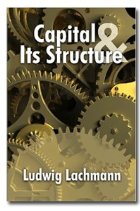 This book [pdf here] provides a wonderful discussion on the theoretical implications of treating capital [goods] as heterogeneous. It may not seem very radical, since everybody knows that a hammer is not exactly the same thing as a ladder, an airplane, or a machine. But to economic theory, this is a radical move. Only in the Austrian school is capital heterogeneity fully embraced and developed, and Lachmann’s Capital and Its Structure is the greatest contribution in this strand of the literature.
This book [pdf here] provides a wonderful discussion on the theoretical implications of treating capital [goods] as heterogeneous. It may not seem very radical, since everybody knows that a hammer is not exactly the same thing as a ladder, an airplane, or a machine. But to economic theory, this is a radical move. Only in the Austrian school is capital heterogeneity fully embraced and developed, and Lachmann’s Capital and Its Structure is the greatest contribution in this strand of the literature.
Lachmann discusses the functions of different capital formations and derives the obvious truth that capital is heterogeneous, which means it has different uses and therefore multiple specificities and complementarities, which in turn implies that capital can be combined in new and unique ways, which can only mean that capital exists in the form of a structure. This structure is ever under pressure from the changing world to continue producing optimal output, which is why an important role for the entrepreneur in the market is to create and change capital formations to make most use of the existing (scarce) capital. This process necessarily takes time, which ties directly in with the unique approach of the Austrian theory of the business cycle.
To me, Lachmann’s discussion confirms much of my own work on the firm and provides a taxonomy and broader reasoning as well as economic rationale for answering how and why firms emerge in a market. It is not simply the case that capital formations can be created and changed through market trade or contracting – it is sometimes necessary to create a high-density to realize and/or maintain such unique structures.
This is, however, where Lachmann fails to realize the true extent of his reasoning. States Lachmann (on pages 41-42):
In a market economy a firm can always vary its capital combination by buying and selling capital goods. hence, each firm will intermittently use the market in order to acquire those capital instruments whcih, when operated by the labour avaialable at current wage rates, will maximize profits.
This statement obviously leaves out the very problematic question of where these markets for factors come from, which directly relates to Mises’s (in contrast to Hayek’s) argument why socialism cannot work. The reason, to Mises, was the lack of markets for factors, which makes economic calculation impossible and therefore undermines successful entrepreneurship. Lachmann, of course, does not need to discuss where capital markets come from – his object is to explain the heterogeneity of capital.
But this is where the theory of the firm perfectly provides the missing piece of the puzzle, and explains both the creation of capital and the creation of capital markets. The firm plays a very central role in the market place.
Leave a Reply